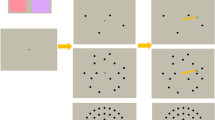Abstract
Background
To ascertain whether the pupillary response amplitude shows spatial summation of responses with increasing size of retinal stimulation, and to examine the pupillary responses for evidence of surround inhibition, analogous to that found in the receptive fields of the retinal ganglion cells.
Methods
By means of infrared-video-pupillography, the pupil reaction to stimuli of increasing size (1–15°) was measured in 30 normal subjects. Four different retinal locations (0°, 20° and 40° eccentricity on the upper temporal retina and 20° eccentricity on the lower nasal retina) were examined at four different stimulus luminances (17, 47, 87 and 140 cd/m2).
Results
When the average log amplitude of the pupil light reaction from the 30 subjects is plotted as a function of the log area of the stimulus, a bi-linear response is observed, which is most pronounced for the two higher luminances. The intersection points of the two linear responses are 2.01° in the fovea, 2.80° at 20° upper temporal retina, 2.85° at 20° lower nasal retina and 4.86° at 40° upper temporal retina.
Conclusions
This study suggests that pupillomotor summation areas consist of both summation and inhibitory zones. They show larger diameters than receptive fields of retinal ganglion cells and do not appear to reflect pupillary summation areas of the pretectal olivary nucleus luminance neurons.



Similar content being viewed by others
References
Hartline HK (1940) The receptive field of the optic nerve fibers. Amer J Physiol 130:690–699
Kuffler SK (1953) Discharge patterns and functional organization of mammalian retina. J Neurophysiol 16:37–68
Hubel DH, Wiesel TN (1960) Receptive field of optic nerve fibers in spider monkey. J Physiol 154:572–580
Jung RL, Spillmann L (1970) Receptive-field estimation and perceptual integration in human vision. In: Young FA, Lindsley DB (eds) Early Experience and Visual Information Processing in Perceptual and Reading Disorders. National Academy of Sciences, Washington DC, pp 181–197
Ricco A (1877) Relazioni fra il minimo angolo visuale e l‘intensitá luminosa. Ann Ottol 6:373–479
Piper H (1903) Über die Abhängigkeit des Reizwertes leuchtender Objekte von ihren Flächen bzw. Winkelgröße. Z Psychol Physiol Sinnesorg 32:98–112
Cibis GW, Campos EC, Aulhorn E (1975) Pupillary hemiakinesia in suprageniculate lesions. Arch Ophthalmol 93:1322–1327
Kardon RH, Kirkali PA, Thompson HS (1991) Automated pupil perimetry. Ophthalmology 98:485–496
Schmid R, Lüdtke H, Wilhelm B, Wilhelm H (2005) Pupil campimetry in patients with visual field loss. Eur J Neurol 12:602–608
Skorkovská K, Wilhelm H, Lüdtke H, Wilhelm B (2009) How sensitive is pupil campimetry in hemifield loss? Graefes Arch Clin Exp Ophthalmol 247:947–953
Gamlin PD, Zhang H, Clarke RJ (1995) Luminance neurons in the pretectal olivary nucleus mediate the pupillary light reflex in the rhesus monkey. Exp Brain Res 106:169–176
Pong M, Fuchs AF (2000) Characteristics of the pupillary light reflex in the macaque monkey: discharge patterns of pretectal neurons. J Neurophysiol 84:964–974
Zhang H, Clarke RJ, Gamlin PD (1996) Behavior of luminance neurons in the pretectal olivary nucleus during the pupillary near response. Exp Brain Res 112:158–162
Zeeh C, Horn AK (2012) The subnuclei of the oculomotor nucleus in humans. Klin Monbl Augenheilkd 229:1083–1089
Hallett PE (1963) Spatial summation. Vision Res 3:9–24
Lucas RJ, Douglas RH, Foster RG (2001) Characterization of an ocular photopigment capable of driving pupillary constriction in mice. Nat Neurosci 4:621–626
Lucas RJ, Hattar S, Takao M, Berson DM, Foster RG, Yau KW (2003) Diminished pupillary light reflex at high irradiances in melanopsin-knockout mice. Science 299:245–247
Alexandridis E (1970) Räumliche und zeitliche Summation pupillomotorisch wirksamer Lichtreize beim Menschen. Albrecht v. Graefes Arch Clin Exp Ophthalmol 180:12–19
Krastel H, Alexandridis E, Gertz J (1985) Pupil increment threshold are influenced by color opponent mechanisms. Ophthalmologica 191:35–38
Acknowledgments
This study was supported by funds of the Marie-Curie-Training Site “Fighting Blindness” QLG5-CT-2001-60034 from the European Union and by the ”Jung Stiftung für Wissenschaft und Forschung.”
Financial interest
The authors confirm they have no financial interest in the research.
Author information
Authors and Affiliations
Corresponding author
Additional information
The authors confirm to have full control of all primary data and agree to allow Graefe´s Archive for Clinical and Experimental Ophthalmology to review their data upon request.
Rights and permissions
About this article
Cite this article
Skorkovská, K., Wilhelm, H., Lüdtke, H. et al. Investigation of summation mechanisms in the pupillomotor system. Graefes Arch Clin Exp Ophthalmol 252, 1155–1160 (2014). https://doi.org/10.1007/s00417-014-2677-4
Received:
Revised:
Accepted:
Published:
Issue Date:
DOI: https://doi.org/10.1007/s00417-014-2677-4




